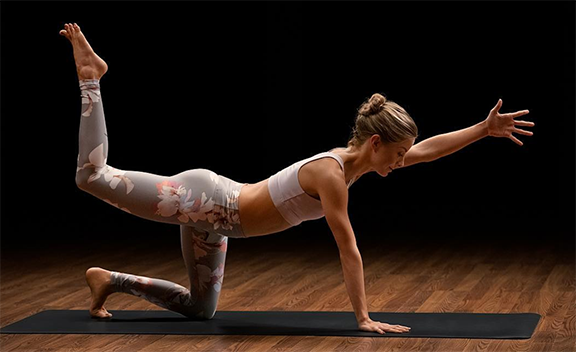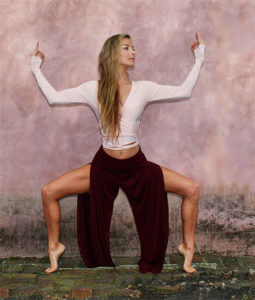 I started Yoga, fairly green, at the age of 19. I was not at all athletic or even interested in exercise before. Nor did I take interest in Yoga the first few times it surfaced in my life. In college, I took one class to satisfy a physical education credit, but I didn’t really want to be there, or in the gym at all, and then my sisters took up hot yoga which I always thought sounded awfully tortuous! My interest grew when I fell in love with someone who wanted to try Yoga. I stepped into a studio to learn with the intentions of sharing the practice with that person. Ambitiously, I jumped right into level two classes (the highest level at the studio) without taking a beginner’s class. I relied on watching the teacher and fellow students, slowly learning through repetition and observation.
I started Yoga, fairly green, at the age of 19. I was not at all athletic or even interested in exercise before. Nor did I take interest in Yoga the first few times it surfaced in my life. In college, I took one class to satisfy a physical education credit, but I didn’t really want to be there, or in the gym at all, and then my sisters took up hot yoga which I always thought sounded awfully tortuous! My interest grew when I fell in love with someone who wanted to try Yoga. I stepped into a studio to learn with the intentions of sharing the practice with that person. Ambitiously, I jumped right into level two classes (the highest level at the studio) without taking a beginner’s class. I relied on watching the teacher and fellow students, slowly learning through repetition and observation.
Six months into this new practice, I remember thinking to myself, “I really like this. I am going to become a teacher.” And so I enrolled in the studio’s 200-hour teacher training. A 200-hour training is the foundational training for any Yoga teacher to become certified through the Yoga Alliance®.
Our intimate group of seven spent the next six months learning about a general style of practice called “flow yoga.” We learned about poses, how to align our bodies, and how to string poses together in flowing sequences. We also learned about the other yogic practices outside of the physical postures, such as pranayama (breathing practices) and meditation. The yogic texts we covered (The Yoga Sutras and Bhagavad Gita) were chock full of new vocabulary such as prana and chakras, which are ancient concepts.
The time flew by, and to my surprise, I was invited to start teaching directly after the conclusion of this training. I taught for a few months post-graduation, reeling from all the information and privately feeling somewhat inadequate to be teaching—my anxiousness was made greater due to the fact that most of the students were my senior. “What can I teach these people?” I would think to myself as the room filled with students.
Intellectually, I knew I had the necessary skills, but emotionally, I felt unsure and exposed. Despite the newbie-nerves, I persisted in teaching and let myself be the new teacher I was. Partially due to my self-doubt and a heightened sense of responsibility, and due to my nature as a voracious learner, I researched 300-hour trainings near me. A 300-hour training is additional, advanced training which Yoga teachers can choose to complete to broaden their education, refresh their knowledge, or dive into a particular style. I liken it to earning a Yoga “master’s degree.” I found an offering at a nearby studio and applied for their 300-hour training.
When my mentor heard about this, she called to advise me against it. “I don’t think you are ready to move forward yet,” she had said, and while I respected her very much, I felt my inner voice saying, “Just do it!” and so I replied, “I appreciate that, but I can’t see anything but good coming out of this for me.” It was uncomfortable to act against my teacher’s advice, but as Judith Lasater says, “Listen to yourself first. Not only, but first.” I started my 300-hour training the same year I finished the 200-hour, full of enthusiasm and with a humbled beginner’s mind. I want to mention here that it is not at all necessary to obtain a 300-hour training to be a fantastic teacher. While training varies in quality, content, and style to some degree, a 200-hour will equip one with enough information to get started, and the basics are really where the marrow of the practice is.
I know several teachers who completed only a 200-hour training who I would consider just as knowledgeable and “advanced” as some other teachers with more training. It is not how much you learn that counts, but the application of that knowledge. In truth, the labels are just stamps that signal to studios and students that there is some standard that has been met in order to teach. I knew 100 percent when I signed up for both trainings that I wanted to teach and learn as much as I could. I didn’t even catch my breath from one training to another. While this is not the best approach for everyone, I am glad I kept my momentum going.
The 300-hour training I enrolled in was more relaxed in its structure, more of a “begin and complete at your own pace” set up. The group was never exactly the same because of this, which made it less intimate but more of a private, personal journey for me. I was completely open to whatever we would be learning and went into it with no expectations.”
The training took me three years to complete, and during that time I learned much more about flow yoga, anatomy, sequencing in creative, fluid ways, the tradition of Yoga, its sister science Ayurveda, mindfulness meditation, associated subjects including Vedic astrology, assists and adjustments, and the influence of sacred rituals surrounding Yoga’s Indian heritage.
I remember one particular weekend very clearly; it was about creating and caring for a personal or studio “altar.” Everyone was given a puja kit, which included some pungent incense, among other things. We all practiced our own puja ceremony, which entailed all 15 of us lighting our incense at the same time. We set off the fire alarm in the building, and my clothes absolutely reeked of patchouli on the way home. While I was completing the 300 hours, I continued to teach and was finishing my Bachelor’s at Penn State University online—so I had a full plate! When I formally graduated as a Registered Yoga Teacher (RYT) 500 (a Hoga teacher with both a 200 and 300-hour training), I was only days away from starting my first master’s of science degree at Georgetown University.
I felt satisfied that I had taken my Yoga education further, felt much more qualified and confident to teach, but also felt a strange sadness since I had completed the entire training sort of “behind the scenes” to the rest of my social and family life. If I could do it over again, I would have involved my friends and family more so that my Yoga community wasn’t compartmentalized to the studio setting alone. As is probably already apparent, when I get into something I go as deep down the rabbit hole as possible. It’s just my personality; I am someone who likes to know how things work and why they work that way. I love to learn and thrive in any kind of educational setting, which served me well me in teacher training.
For anyone interested in teacher training, a thirst for knowledge and a commitment to yourself is really all that is necessary to succeed, but organization skills and mental stamina help a lot, too. The weekends are usually long (roughly 20 hours each in my experience), require home practice, teaching in front of groups, reading and writing assignments, and getting up early Saturday and Sunday, among other things.
Yoga training can be taxing in a variety of ways, but it is fulfilling in just as many. Embracing being a beginner is another thing that can make the process more enjoyable. It is scary to put yourself out there, to not know what to do or say, but that is the nature of being a beginner. After completing these two trainings, teaching my own trainings, two master’s degrees in the sciences, and now starting my Ph.D., I still often feel like a beginner. I am, of course, more confident and am intimately familiar with the information, but I don’t think I will ever feel like I finally know everything or am the Grand Pooh-Bah of all things Yoga.
Letting yourself be the student, being okay with making mistakes and not knowing everything now, is a gift you can give to yourself to take the pressure off and enjoy your journey unfolding. Plus, every great teacher has gotten where they are by first being a beginner.
If you love Yoga and learning how things work underneath the hood, I recommend taking a 200-hour Yoga training, whether you want to teach or not. If you want to go beyond that material and learn more in a training setting, take a 300-hour. Maybe you discover a new style, or want to earn another certification for a specific population. Or maybe, you want to build your confidence, and it’s been a long time since your first training and you’re looking for renewed inspiration. Your reasons will be personal, and it is your choice. I know students who have done all the training but have no desire to teach, and I also know students who did not want to teach at all at first who are teaching classes now. It is also fine to take zero training and do the most important thing of all—practice!
Being a practitioner and doing the practice is always, always enough. Plus, you can enjoy your teachers’ practices without the added mental analysis and critique which can run through a fellow teacher’s mind, and instead, you can allow the class’s origination to remain a mystery. Whatever you decide, may it increase your interest and appreciation for the practice and not diminish it or create tension. The right programs and people will leave you feeling eager to learn more and feel supported for all the right reasons.
Listen to that inner voice and make a solid, inner decision that will help you stay true to your path. As Lasater said, “Listen to yourself first. Not only, but first.”
 About the Author:
About the Author:

